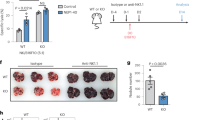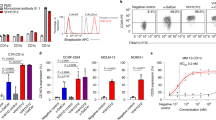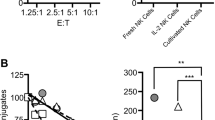Abstract
The intracellular signals that trigger natural cytotoxicity have not been clearly determined. The Syk and ZAP-70 tyrosine kinases are essential for cellular activation initiated by B and T cell antigen receptors and may drive natural killer (NK) cell cytotoxicity via receptors bearing immunoreceptor tyrosine-based activation motifs (ITAMs). However, we found that, unlike B and T cells, NK cells developed in Syk−/−ZAP-70−/− mice and, despite their nonfunctional ITAMs, lysed various tumor targets in vitro and eliminated tumor cells in vivo, including those without NKG2D ligands. The simultaneous inhibition of phosphotidyl inositol 3 kinase and Src kinases abrogated the cytolytic activity of Syk−/−ZAP-70−/− NK cells and strongly reduced that of wild-type NK cells. This suggests that distinct and redundant signaling pathways act synergistically to trigger natural cytotoxicity.
This is a preview of subscription content, access via your institution
Access options
Subscribe to this journal
Receive 12 print issues and online access
$209.00 per year
only $17.42 per issue
Buy this article
- Purchase on Springer Link
- Instant access to full article PDF
Prices may be subject to local taxes which are calculated during checkout







Similar content being viewed by others
References
Lanier, L. L. On guard-activating NK cell receptors. Nature Immunol. 2, 23–27 (2001).
Moretta, A. et al. Activating receptors and coreceptors involved in human natural killer cell-mediated cytolysis. Annu. Rev. Immunol. 19, 197–223 (2001).
Wu, J. et al. An activating immunoreceptor complex formed by NKG2D and DAP10. Science 285, 730–732 (1999).
Bauer, S. et al. Activation of NK cells and T cells by NKG2D, a receptor for stress-inducible MICA. Science 285, 727–729 (1999).
Cerwenka, A. et al. Retinoic acid early inducible genes define a ligand family for the activating NKG2D receptor in mice. Immunity 12, 721–727 (2000).
Diefenbach, A., Jamieson, A. M., Liu, S. D., Shastri, N. & Raulet, D. Ligands for the murine NKG2D receptor: expression by tumor cells and activation of NK cells and macrophages. Nature Immunol. 1, 119–126 (2000).
Isakov, N. Role of immunoreceptor tyrosine-based activation motif in signal transduction from antigen and Fc receptors. Adv. Immunol. 69, 183–247 (1998).
Elder, M. E. et al. Human severe combined immunodeficiency due to a defect in ZAP-70, a T cell tyrosine kinase. Science 264, 1596–1601 (1994).
Negishi, I. et al. Essential role for ZAP-70 in both positive and negative selection of thymocytes. Nature 376, 435–438 (1995).
Kadlecek, T. A. et al. Differential requirements for ZAP-70 in TCR signaling and T cell development. J. Immunol. 161, 4688–4694 (1998).
Turner, M. et al. Perinatal lethality and blocked B-cell development in mice lacking the tyrosine kinase Syk. Nature 378, 298–302 (1995).
Cheng, A. M. et al. Syk tyrosine kinase required for mouse viability and B-cell development. Nature 378, 303–306 (1995).
Colucci, F. et al. Redundant role of the Syk protein tyrosine kinase in mouse NK cell differentiation. J. Immunol . 163, 1769–1774 (1999).
Brumbaugh, K. M. et al. Functional role for Syk tyrosine kinase in natural killer cell-mediated natural cytotoxicity. J. Exp. Med. 186, 1965–1974 (1997).
Turner, M., Schweighoffer, E., Colucci, F., Di Santo, J. P. & Tybulewicz, V. L. J. Tyrosine kinase Syk: essential functions for immunoreceptor signalling revealed by gene targeted mice. Immunol. Today 21, 148–154 (2000).
Colucci, F. et al. Dissecting NK cell development using a novel alymphoid mouse model: investigating the role of the c-abl proto-oncogene in murine NK cell differentiation. J. Immunol. 162, 2761–2765 (1999).
Kiessling, R., Klein, E. & Wigzell, H. “Natural” killer cells in the mouse. I. Cytotoxic cells with specificity for mouse Moloney leukemia cells. Specificity and distribution according to genotype. Eur. J. Immunol. 5, 112–117 (1975).
Tomasello, E. et al. Combined natural killer cell and dendritic cell functional deficiency in KARAP/DAP12 loss-of-function mutant mice. Immunity 13, 355–364 (2000).
Shores, E. W. et al. T cell development in mice lacking all T cell receptors ζ family members. J. Exp. Med. 187, 1093–1101 (1998).
Lin, S. Y., Ardouin, L., Gillet, A., Malissen, M. & Malissen, B. The single positive T cells found in CD3-ζ/η−/− mice overtly react with self-major histocompatibility complex molecules upon restoration of normal surface density of T cell receptor-CD3 complex. J. Exp. Med. 185, 707–715 (1997).
Hoglund, P., Glas, R., Ohlen, C., Ljunggren, H. G. & Karre, K. Alteration of the natural killer repertoire in H-2 transgenic mice: specificity of rapid lymphoma cell clearance determined by the H-2 phenotype of the target. J. Exp. Med. 174, 327–334 (1991).
Colucci, F. et al. Functional dichotomy in NK cell signaling: Vav1-dependent and independent mechanisms. J. Exp. Med. 193, 1413–1424 (2001).
Idris, A. H. et al. The natural killer gene complex genetic locus Chok encodes Ly-49D, a target recognition receptor that activates natural killing. Proc. Natl Acad. Sci. USA 96, 6330–6335 (1999).
Brown, M. G. et al. Vital involvement of a natural killer cell activation receptor in resistance to viral infection. Science 292, 934–937 (2001).
Daniels, K. A. et al. Murine cytomegalovirus is regulated by a discrete subset of natural killer cells reactive with monoclonal antibody to ly49h. J. Exp. Med. 194, 29–44 (2001).
Lee, S. H. et al. Susceptibility to mouse cytomegalovirus is associated with deletion of an activating natural killer cell receptor of the C-type lectin superfamily. Nature Genet. 1, 42–45 (2001).
Binstadt, B. A. et al. Sequential involvement of Lck and SHP-1 with MHC-recognizing receptors on NK cells inhibits FcR-initiated tyrosine kinase activation. Immunity 5, 629–638 (1996).
Bonnema, J. D., Karnitz, L. M., Schoon, R. A., Abraham, R. T. & Leibson, P. J. Fc receptor stimulation of phosphatidylinositol 3-kinase in natural killer cells is associated with protein kinase C-independent granule release and cell-mediated cytotoxicity. J. Exp. Med. 180, 1427–1435 (1994).
Chu, D. H., Morita, C. T. & Weiss, A. The Syk family of protein tyrosine kinases in T-cell activation and development. Immunol. Rev. 165, 167–180 (1998).
Aderem, A. & Underhill, D. Mechanisms of phagocytosis in macrophages. Annu. Rev. Immunol. 17, 593–623 (1999).
Jiang, K. Pivotal role of phosphoinositide-3 kinase in regulation of cytotoxicity in natural killer cells. Nature Immunol. 1, 419–425 (2000).
Mainiero, F. et al. RAC1/P38 MAPK signaling pathway controls β1 integrin-induced interleukin-8 production in human natural killer cells. Immunity 12, 7–16 (2000).
Helander, T. S. et al. ICAM-2 redistributed by ezrin as a target for killer cells. Nature 382, 265–268 (1996).
Spanopoulu, E. et al. Functional immunoglobulin transgenes guide ordered B-cell differentiation in Rag-1-deficient mice. Genes Dev. 8, 1030–1042 (1994).
Acknowledgements
We thank T. Kadlecek and A. Weiss for the ZAP-70−/− mice; P. Love for the FcRγ−/−CD3ζ−/− mice; E. Corcuff and O. Richard for skillful help; S. Samson, C. Roth, C. Vosshenrich, D. McVicar, A. Diefenbach, D. Raulet and E. Long for constructive discussions; and G. Langsley and O. Acuto for critically reading the manuscript. Supported by grants from The Pasteur Institute, Ligue Nationale Contre le Cancer, Association pour la Recherche sur le Cancer and the Institut National de la Santé et de la Recherche Medicale (to F. C. and J. P. D.); the European Molecular Biology Organization (to E. S.); the Medical Research Council (to V. L .J .T.); the Babraham Institute (to M. T.); and the Fondation pour la Recherche Medicale to (E. T).
Author information
Authors and Affiliations
Corresponding author
Ethics declarations
Competing interests
The authors declare no competing financial interests.
Rights and permissions
About this article
Cite this article
Colucci, F., Schweighoffer, E., Tomasello, E. et al. Natural cytotoxicity uncoupled from the Syk and ZAP-70 intracellular kinases. Nat Immunol 3, 288–294 (2002). https://doi.org/10.1038/ni764
Received:
Accepted:
Published:
Issue Date:
DOI: https://doi.org/10.1038/ni764
This article is cited by
-
Transcriptional regulation of innate lymphoid cell fate
Nature Reviews Immunology (2015)
-
NKG2D Triggers Cytotoxicity in Murine Epidermal γδ T Cells via PI3K-Dependent, Syk/ZAP70-Independent Signaling Pathway
Journal of Investigative Dermatology (2014)
-
Current perspectives of natural killer cell education by MHC class I molecules
Nature Reviews Immunology (2010)
-
The SYK tyrosine kinase: a crucial player in diverse biological functions
Nature Reviews Immunology (2010)
-
Up on the tightrope: natural killer cell activation and inhibition
Nature Immunology (2008)



